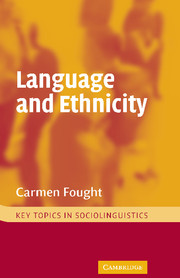Book contents
- Frontmatter
- Contents
- Preface
- Acknowledgments
- Part I General issues in ethnicity and language
- Part II Linguistic features and ethnicity in specific groups
- 3 African-American groups
- 4 Latino groups
- 5 Linguistic variation in other multiethnic settings
- 6 Are white people ethnic? Whiteness, dominance, and ethnicity
- 7 Dialect contact, ethnicity, and language change
- Part III The role of language use in ethnicity
- Notes
- Glossary of terms
- References
- Index
- References
6 - Are white people ethnic? Whiteness, dominance, and ethnicity
Published online by Cambridge University Press: 05 September 2012
- Frontmatter
- Contents
- Preface
- Acknowledgments
- Part I General issues in ethnicity and language
- Part II Linguistic features and ethnicity in specific groups
- 3 African-American groups
- 4 Latino groups
- 5 Linguistic variation in other multiethnic settings
- 6 Are white people ethnic? Whiteness, dominance, and ethnicity
- 7 Dialect contact, ethnicity, and language change
- Part III The role of language use in ethnicity
- Notes
- Glossary of terms
- References
- Index
- References
Summary
“[clear throat] Oh goodness! [clear throat]”
“What's the matter, Chance?”
“[clear throat] I don't know, Schuyler. [clear throat] I have a scratchy sensation I am not familiar with. [clear throat] I better schedule an MRI[clear throat].”
(George Lopez doing “white” characters, Right Now Right Now, 2001)I discuss issues of racial identity, including what it means to be “white,” with my colleagues and students all the time. But my first experience with this particular concept outside the academic setting occurred when my husband and I were having dinner at a Mexican restaurant (a big chain type) near our home in Southern California. We got into a conversation with the waiter, who was European-American, on the topic of beers. My husband, for reasons known only to himself, asked, “What's the first beer you remember drinking?” The waiter answered, “Budweiser,” but he followed up with a comment that interested me. “You gotta understand,” he explained, “my family is all white people, you know? I don't mean to be racist or anything, but it's true. And that's what they drink: Budweiser, Miller Genuine Draft, or Coors.” Many things struck me about this response: his stereotyping of whites as a group, his apology and identification of the stereotype as potential racism, and his willingness to discuss issues about his family's construction of ethnicity with two total strangers.
- Type
- Chapter
- Information
- Language and Ethnicity , pp. 112 - 132Publisher: Cambridge University PressPrint publication year: 2006

